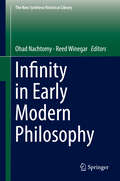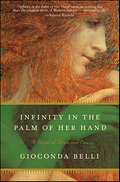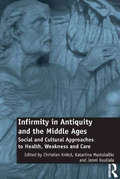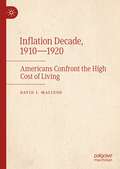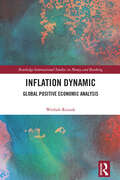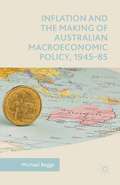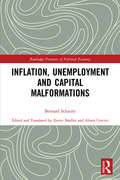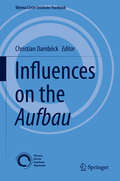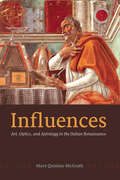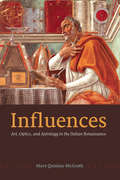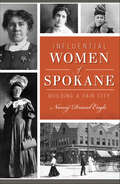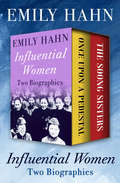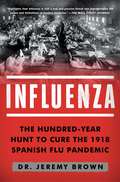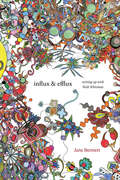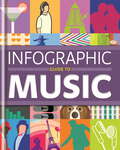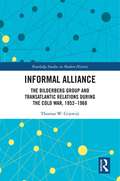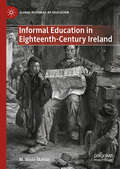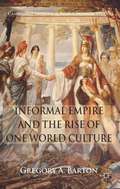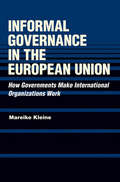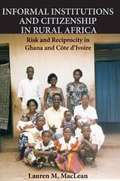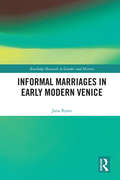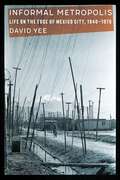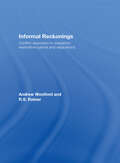- Table View
- List View
Infinity in Early Modern Philosophy (The\new Synthese Historical Library #76)
by Ohad Nachtomy Reed WinegarThis volume contains essays that examine infinity in early modern philosophy. The essays not only consider the ways that key figures viewed the concept. They also detail how these different beliefs about infinity influenced major philosophical systems throughout the era. These domains include mathematics, metaphysics, epistemology, ethics, science, and theology.Coverage begins with an introduction that outlines the overall importance of infinity to early modern philosophy. It then moves from a general background of infinity (before early modern thought) up through Kant. Readers will learn about the place of infinity in the writings of key early modern thinkers. The contributors profile the work of Descartes, Spinoza, Leibniz, and Kant. Debates over infinity significantly influenced philosophical discussion regarding the human condition and the extent and limits of human knowledge. Questions about the infinity of space, for instance, helped lead to the introduction of a heliocentric solar system as well as the discovery of calculus. This volume offers readers an insightful look into all this and more. It provides a broad perspective that will help advance the present state of knowledge on this important but often overlooked topic.
Infinity in the Palm of Her Hand: A Novel of Adam and Eve
by Gioconda Belli“Ingenious.” —Vogue“Infinity in the Palm of Her Hand takes on nothing less than the creation myth of Western culture.” —Salman RushdieThe winner of the prestigious 2008 Biblioteca Breve Prize—joining such renowned Latin American luminaries as Mario Vargas Llosa and Carlos Fuentes—acclaimed poet and novelist Gioconda Belli’s Infinity in the Palm of Her Hand is a wholly creative and original re-imagining of the story of Adam and Eve and original sin. In a brilliant translation by Margaret Sayers Peyden, this remarkable new look at the Book of Genesis will appeal to readers of the novels of Isabel Allende, Anne Rice’s Jesus Chronicles, and to all lovers of great imaginative literature.
Infirmity in Antiquity and the Middle Ages: Social and Cultural Approaches to Health, Weakness and Care
by Christian Krötzl Katariina Mustakallio Jenni KuulialaThis volume discusses infirmitas (’infirmity’ or ’weakness’) in ancient and medieval societies. It concentrates on the cultural, social and domestic aspects of physical and mental illness, impairment and health, and also examines frailty as a more abstract, cultural construct. It seeks to widen our understanding of how physical and mental well-being and weakness were understood and constructed in the longue durée from antiquity to the Middle Ages. The chapters are written by experts from a variety of disciplines, including archaeology, art history and philology, and pay particular attention to the differences of experience due to gender, age and social status. The book opens with chapters on the more theoretical aspects of pre-modern infirmity and disability, moving on to discuss different types of mental and cultural infirmities, including those with positive connotations, such as medieval stigmata. The last section of the book discusses infirmity in everyday life from the perspective of healing, medicine and care.
Inflation Decade, 1910—1920: Americans Confront the High Cost of Living
by David I. MacleodThis book shows how inflation can disrupt politics and society. With no recent precedent, mild inflation spurred mass protests, myriad remedial schemes, and partisan political reversals between 1910 and 1914. Then wartime demand and inflationary fiscal policy doubled consumer prices from 1915 to 1920, triggering waves of strikes, food riots by immigrant housewives, class conflict, and elite fears of revolution. Middle-class households resented falling real incomes. Even more than today, food prices dominated consumer concerns. Yet farmers wanted high commodity prices. Accordingly, both sides blamed and attacked meatpackers, wholesalers, and retailers. Then as now, inflation hurt whichever party held the White House. Fumbling responses by Wilson’s administration and the Federal Reserve led to hesitant price controls, punitive raids and prosecutions, and a now-familiar fallback—high interest rates in 1920 and subsequent recession. An epilogue traces continuing popular and politicalresponses to changes in the consumer price index down to 2020.
Inflation Dynamic: Global Positive Economic Analysis (Routledge International Studies in Money and Banking)
by Weshah RazzakThis book explains inflation dynamic, using time series data from 1960 for 42 countries. These countries are different in every aspect, historically, culturally, socially, politically, institutionally, and economically. They are chosen on the basis of the data availability only and cover the Middle East and North Africa (MENA) region, Africa, Asia, the Caribbean, Europe, Australasia, and the United States. Inflation reached double digits in the developed countries in the 1970s and 80s, and then central banks, successfully stabilized it by anchoring inflation expectations for decades, until now. Conditional on common and country-specific shocks such as oil price shocks, financial and banking and political crises, wars, pandemics, natural disasters etc., the book tests various theoretical models about the long and short run relationships between money and prices, money growth and inflation, money growth and real output, expected inflation; the output gap, fiscal policy, and inflation, using a number of parametric and non-parametric methods, and pays attention to specifications and estimations problems. In addition, it explains why policymakers in inflation – targeting countries, e.g. the U.S., failed to anticipate the recent sudden rise in inflation. And, it examines the fallibility of the Modern Monetary Theory’s policy prescription to reduce inflation by raising taxes. This is a unique and innovative book, which will find an audience among students, academics, researchers, policy makers, analysts in corporations, private and central banks and international monetary institutions.
Inflation and the Making of Australian Macroeconomic Policy, 1945–85
by Michael BeggsIn the decades after World War II, inflation undermined the aspiration for full employment in Australia. This book tells the story of how the Australian state was shaped by the confrontation with monetary instability: a pre-history of neoliberalism.
Inflation, Unemployment and Capital Malformations (Routledge Frontiers of Political Economy)
by Alvaro Cencini Bernard Schmitt Xavier BradleyThe volume deals with the main problems faced by capitalist economies, inflation and unemployment, in a new and original way, and provides the theoretical foundations for quantum macroeconomic analysis. Its aim is to allow English-speaking economists and interested readers to have a direct access to the analysis provided by Schmitt in his 1984 book Inflation, chômage et malformations du capital. Orthodox economics has failed to provide a consistent insight of the pathologies hindering our economies, and both the academic and the economic worlds are much in need for an alternative approach capable to explain the origins of these pathologies and how they can eventually be disposed of. Schmitt’s volume provides a revolutionary explanation of the cause of today’s economic disorder as well as an innovative solution allowing for the passage from disorder to order. Neoclassical and Keynesian theories of any type are essentially based on equilibrium analysis and this is why none of them has ever been able to provide a consistent macroeconomic analysis based on macroeconomic foundations. This is what Schmitt’s book aims for: developing a new analysis built on identities rather than conditions of equilibrium, capable to explain the objective origins of inflation and unemployment. In this volume, Schmitt introduces a new, revolutionary analysis centred on the concept of quantum time. The topics analysed by Schmitt cover the entire field of national macroeconomics, from production to capital accumulation, the leading role in this ground-breaking investigation being played by what he calls the theory of emissions. The ensuing macroeconomic theory is built on a set of laws derived from the monetary nature of our economic systems and defines the logical framework of inquiry into modern macroeconomics.
Influences on the Aufbau
by Christian DamböckThis volume offers 11 papers that cover the wide spectrum of influences on Rudolf Carnap's seminal work, Der Logische Aufbau der Welt (The Logical Structure of the World). Along the way, it covers a host of topics related to this important philosophical work, including logic, theories of order, science, hermeneutics, and mathematics in the Aufbau, as the work is commonly termed. The book uncovers the influences of such neglected figures as Gerhards, Driesch, Ziehen, and Ostwald. It also presents new evidence on influences of well-known figures in philosophy, including Husserl, Rickert, Schlick, and Neurath. In addition, the book offers comparisons of the Aufbau with the work of contemporary scientists such as Weyl and Wiener as well as features new archival findings on the early Carnap. This book will appeal to researchers and students with an interest in the history and philosophy of science, history of analytic philosophy, the philosophy of the Vienna Circle, and the philosophy in interwar Germany and Austria.
Influences: Art, Optics, and Astrology in the Italian Renaissance
by Mary Quinlan-McGrathToday few would think of astronomy and astrology as fields related to theology. Fewer still would know that physically absorbing planetary rays was once considered to have medical and psychological effects. But this was the understanding of light radiation held by certain natural philosophers of early modern Europe, and that, argues Mary Quinlan-McGrath, was why educated people of the Renaissance commissioned artworks centered on astrological themes and practices. Influences is the first book to reveal how important Renaissance artworks were designed to be not only beautiful but also—perhaps even primarily—functional. From the fresco cycles at Caprarola, to the Vatican’s Sala dei Pontefici, to the Villa Farnesina, these great works were commissioned to selectively capture and then transmit celestial radiation, influencing the bodies and minds of their audiences. Quinlan-McGrath examines the sophisticated logic behind these theories and practices and, along the way, sheds light on early creation theory; the relationship between astrology and natural theology; and the protochemistry, physics, and mathematics of rays. An original and intellectually stimulating study, Influences adds a new dimension to the understanding of aesthetics among Renaissance patrons and a new meaning to the seductive powers of art.
Influences: Art, Optics, and Astrology in the Italian Renaissance
by Mary Quinlan-McgrathToday few would think of astronomy and astrology as fields related to theology. Fewer still would know that physically absorbing planetary rays was once considered to have medical and psychological effects. But this was the understanding of light radiation held by certain natural philosophers of early modern Europe, and that, argues Mary Quinlan-McGrath, was why educated people of the Renaissance commissioned artworks centered on astrological themes and practices. Influences is the first book to reveal how important Renaissance artworks were designed to be not only beautiful but also--perhaps even primarily--functional. From the fresco cycles at Caprarola, to the Vatican's Sala dei Pontefici, to the Villa Farnesina, these great works were commissioned to selectively capture and then transmit celestial radiation, influencing the bodies and minds of their audiences. Quinlan-McGrath examines the sophisticated logic behind these theories and practices and, along the way, sheds light on early creation theory; the relationship between astrology and natural theology; and the protochemistry, physics, and mathematics of rays. An original and intellectually stimulating study, Influences adds a new dimension to the understanding of aesthetics among Renaissance patrons and a new meaning to the seductive powers of art.
Influential Women of Spokane: Building a Fair City (American Heritage)
by Nancy Driscol EngleWhile known as the home of Father's Day, Spokane benefited from its share of trailblazing women. In 1886, Mother Joseph, a pioneering architect, constructed the first Sacred Heart Hospital. After fire destroyed thirty-six blocks in 1889, Anna Stratton Browne and her friends raised $10,000 to build a home for needy children that operated for six decades. And in early 1908, May Hutton became president of the Spokane Equal Suffrage League, persevering until 1910, when Washington voters gave women the vote. Historian Nancy Driscol Engle commemorates the unforgettable contributions of Spokane's women.
Influential Women: Two Biographies
by Emily HahnPortraits of pivotal American feminists and three of the most powerful women in twentieth-century China by the &“quintessential New Yorker narrator&” (The New York Times). Once Upon a Pedestal: After living an unconventional and exotic life for decades, New Yorker writer Emily Hahn was in her late sixties when this book was first published in 1974. As the Women&’s Movement continued to gain momentum, Hahn penned this &“essential history of the remarkable women who led the feminist movement in America.&” Her &“excellent and eminently readable&” biographical sketches include Susan B. Anthony, Clara Barton, Fanny Wright, the Grimké sisters, Margaret Sanger, Jane Addams, Victoria Woodhull, Harriet Martineau, Eleanor Roosevelt, and Betty Friedan (Publishers Weekly). &“[The] quintessential New Yorker narrator whose adventures over the last forty years have intrigued, amused and educated . . . Emily Hahn is, herself, a role model. It is fitting and felicitous for her to give us an armchair guide to strong-minded American women.&” —The New York Times The Soong Sisters: In 1935, intrepid journalist and fearless feminist Emily Hahn traveled to China and sent dispatches to the New Yorker. Through her lover, the Chinese poet Shao Xunmei, she met and established close bonds with three of the most instrumental women in twentieth-century Chinese history, who happened to be sisters. The Soong family was arguably the most influential family in Shanghai, even more so as eldest sister Eling married finance minister H. H. Kung; middle sister Chingling married Sun Yat-Sen, the founding father and first president of the Republic of China; and youngest sister Mayling married Chiang Kai-Shek, who succeeded Sun as the leader of the Republic of China. Hahn&’s chronicle of the family&’s history, written while bombs were falling during the Second Sino-Japanese War, and published in 1941, while Hahn was still in Japanese-occupied Hong Kong, is a vivid, comprehensive, and uniquely personal account of the sisters who would become known to the world as Madame Kung, Madame Sun, and Madame Chiang Kai-Shek. &“First rate reportorial job on three distinguished women . . . [a] tribute to their work and their individual heroisms.&” —Kirkus Reviews
Influenza 1918
by Esyllt W. JonesThe influenza pandemic of 1918-1919 killed as many as fifty million people worldwide and affected the vast majority of Canadians. Yet the pandemic, which came and left in one season, never to recur in any significant way, has remained difficult to interpret. What did it mean to live through and beyond this brief, terrible episode, and what were its long-term effects? Influenza 1918 uses Winnipeg as a case study to show how disease articulated abd helped to re-define boundaries of social difference. Esyllt W. Jones examines the impact of the pandemic in this fragmented community, including its role in the eruption of the largest labour confrontation in Canadian history, the Winnipeg General Strike of 1919. Arguing that labour historians have largely ignored the impact of infectious disease upon the working class, Jones draws on a wide range of primary sources including mothers' allowance and orphanage case files in order to trace the pandemic's affect on the family, the public health infrastructure, and other social institutions. This study brings into focus the interrelationships between epidemic disease and working class, gender, labour, and ethnic history in Canada.Influenza 1918 concludes that social conflict is not an inevitable outcome of epidemics, but rather of inequality and public failure to fully engage all members of the community in the fight against disease.
Influenza: The Hundred Year Hunt to Cure the Deadliest Disease in History
by Jeremy BrownOn the 100th anniversary of the devastating pandemic of 1918, Jeremy Brown, a veteran ER doctor, explores the troubling, terrifying, and complex history of the flu virus, from the origins of the Great Flu that killed millions, to vexing questions such as: are we prepared for the next epidemic, should you get a flu shot, and how close are we to finding a cure? <P><P>While influenza is now often thought of as a common and mild disease, it still kills over 30,000 people in the US each year. Dr. Jeremy Brown, currently Director of Emergency Care Research at the National Institutes of Health, expounds on the flu's deadly past to solve the mysteries that could protect us from the next outbreak. <P><P>In Influenza, he talks with leading epidemiologists, policy makers, and the researcher who first sequenced the genetic building blocks of the original 1918 virus to offer both a comprehensive history and a roadmap for understanding what’s to come. Dr. Brown digs into the discovery and resurrection of the flu virus in the frozen victims of the 1918 epidemic, as well as the bizarre remedies that once treated the disease, such as whiskey and blood-letting. \ <P><P>Influenza also breaks down the current dialogue surrounding the disease, explaining the controversy over vaccinations, antiviral drugs like Tamiflu, and the federal government’s role in preparing for pandemic outbreaks. Though 100 years of advancement in medical research and technology have passed since the 1918 disaster, Dr. Brown warns that many of the most vital questions about the flu virus continue to confound even the leading experts. <P><P>Influenza is an enlightening and unnerving look at a shapeshifting deadly virus that has been around long before people—and warns us that it may be many more years before we are able to conquer it for good.
Influx and Efflux: Writing Up with Walt Whitman
by Jane BennettIn influx & efflux Jane Bennett pursues a question that was bracketed in her book Vibrant Matter: how to think about human agency in a world teeming with powerful nonhuman influences? “Influx & efflux”—a phrase borrowed from Whitman's "Song of Myself"—refers to everyday movements whereby outside influences enter bodies, infuse and confuse their organization, and then exit, themselves having been transformed into something new. How to describe the human efforts involved in that process? What kinds of “I” and “we” can live well and act effectively in a world of so many other lively materialities? Drawing upon Whitman, Thoreau, Caillois, Whitehead, and other poetic writers, Bennett links a nonanthropocentric model of self to a radically egalitarian pluralism and also to a syntax and style of writing appropriate to the entangled world in which we live. The book tries to enact the uncanny process by which we “write up” influences that pervade, enable, and disrupt us.
Infographic Guide to Music (Infographic Guides)
by Graham BettsOver 80 stunning, ingenious and absorbing music infographics! Infographic Guide to Music presents unique, witty and surprising facts about every music genre, from pop, rock, indie, house, dance, electronic, rap, country and classical. Mixing musical stats with facts on all your favourite leading legends, it features infamous and often ludicrous tales of the music business.More than just a book of words, with graphs, Venn diagrams and charts, this book provides a unique overview of the music world, boasting over 100 original artworks and illustrations and at-a-glance facts to amaze and astound readers.
Informal Alliance: The Bilderberg Group and Transatlantic Relations during the Cold War, 1952-1968 (Routledge Studies in Modern History)
by Thomas W. GijswijtInformal Alliance is the first archive-based history of the secretive Bilderberg Group, the high-level transatlantic elite network founded at the height of the Cold War. Making extensive use of the recently opened Bilderberg Group archives as well as a wide range of private and official collections, it shows the significance of informal diplomacy in a fast-changing world of Cold War, decolonization, and globalization. By analyzing the global mindset of the postwar transatlantic elite and by focusing on private, transnational modes of communication and coordination, this study provides important new insights into the history of transatlantic relations, anti-Americanism, Western anti-communism, and European integration during the 1950s and 1960s. Informal Alliance also debunks the persistent myth that the Bilderberg Group was created by the CIA and repudiates widespread conspiracy theories alleging that Bilderberg was some sort of secret world government.
Informal Education in Eighteenth-Century Ireland (Global Histories of Education)
by M. Wade MahonThis book documents an informal system of education that emerged in Ireland between the late 1750s and the end of the century, a system that operated largely without funding or direction by church or state. In a society as divided as eighteenth-century Ireland, it is remarkable that such a system could succeed, paving the way for the more formal reforms of Irish education that followed in the nineteenth century. Based on detailed evidence from newspaper advertisements, directories, educational prospectuses, textbooks, and other print documents from the period as well as previously unexamined manuscript resources, the author describes this system and how it functioned, emphasizing the transnational dimensions of print culture, English literature, and education reform.
Informal Empire and the Rise of One World Culture
by Gregory A. BartonInformal empire is a key mechanism of control that explains much of the configuration of the modern world. This book traces the broad outline of westernization through elite formations around the world in the modern era. It explains why the world is western and how formal empire describes only the tip of the iceberg of British and American power.
Informal Governance in the European Union: How Governments Make International Organizations Work
by Mareike KleineThe European Union is the world’s most advanced international organization, presiding over a level of legal and economic integration unmatched in global politics. To explain this achievement, many observers point to its formal rules that entail strong obligations and delegate substantial power to supranational actors such as the European Commission. This legalistic view, Mareike Kleine contends, is misleading. More often than not, governments and bureaucrats informally depart from the formal rules and thereby contradict their very purpose. Behind the EU’s front of formal rules lies a thick network of informal governance practices.If not the EU’s rules, what accounts for the high level of economic integration among its members? How does the EU really work? In answering these questions, Kleine proposes a new way of thinking about international organizations. Informal governance affords governments the flexibility to resolve conflicts that adherence to EU rules may generate at the domestic level. By dispersing the costs that integration may impose on individual groups, it allows governments to keep domestic interests aligned in favor of European integration. The combination of formal rules and informal governance therefore sustains a level of cooperation that neither regime alone permits, and it reduces the EU’s democratic deficit by including those interests into deliberations that are most immediately affected by its decisions. In illustrating informal norms and testing how they work, Kleine provides the first systematic analysis, based on new material from national and European archives and other primary data, of the parallel development of the formal rules and informal norms that have governed the EU from the 1958 Treaty of Rome until today.
Informal Institutions and Citizenship in Rural Africa
by Lauren M. MacleanThis book challenges previous assumptions about institutions, social capital, and the nature of the African state by investigating the history of political and economic change in villages on either side of the Ghana-Cote d'Ivoire border. Prior to European colonial rule, these Akan villages had very similar political and cultural institutions. By the late 1990s, however, Lauren M. MacLean found puzzling differences in the informal institutions of reciprocity and indigenous notions of citizenship. MacLean argues that divergent histories of state formation not only shape how villagers help each other but also influence how local groups and communities define citizenship and then choose to engage with the state on an everyday basis. She examines the historical construction of the state role in mediating risk at the local level across three policy areas: political administration, social service delivery, and agriculture.
Informal Marriages in Early Modern Venice (Routledge Research in Gender and History #33)
by Jana ByarsConditions of the marriage market and sexual culture, and the needs of wealthy families and their members created social tensions in the late sixteenth and early-seventeenth century Venice. This study details these tensions and discusses concubinage– a long-term, sexual, non-marital union - as an alternate family model that soothed them by meeting the needs of families and individuals in a manner that did not offend the sensibilities of the authorities or other Venetians. Concubinage was quite common, and the Venetian community regularly accepted concubinaries, concubinal relationships, and the offspring concubinage produced.
Informal Metropolis: Life on the Edge of Mexico City, 1940–1976 (Confluencias)
by David YeeIn the 1940s, as Mexican families trekked north to the United States in search of a better life, tens of millions also left their towns and villages for Mexico&’s major cities. In Mexico City migrant families excluded from new housing programs began to settle on a dried-out lake bed near the airport, eventually transforming its dusty plains into an informal city of more than one million people. In Informal Metropolis David Yee uncovers how this former lake bed grew into the world&’s largest shantytown—Ciudad Nezahualcóyotl—and rethinks the relationship between urban space and inequality in twentieth-century Mexico. By chronicling the residents&’ struggles to build their own homes and gain land rights in the face of extreme adversity, Yee presents a hidden history of land fraud, political corruption, and legal impunity underlying the rise of Mexico City&’s informal settlements. When urban social movements erupted across Mexico in the 1970s, Ciudad Nezahualcóyotl&’s residents organized to demand land, water, and humane living conditions. Though guided by demands for basic needs, these movements would ultimately achieve a more lasting significance as a precursor to a new urban citizenry in Mexico. In the first comprehensive history of modern housing in Mexico City, Yee challenges widely held assumptions about urban inequality and politics in Mexico.
Informal Order and the State in Afghanistan
by Jennifer Brick MurtazashviliDespite vast efforts to build the state, profound political order in rural Afghanistan is maintained by self-governing, customary organizations. Informal Order and the State in Afghanistan explores the rules governing these organizations to explain why they can provide public goods. Instead of withering during decades of conflict, customary authority adapted to become more responsive and deliberative. Drawing on hundreds of interviews and observations from dozens of villages across Afghanistan, and statistical analysis of nationally representative surveys, Jennifer Murtazashvili demonstrates that such authority enhances citizen support for democracy, enabling the rule of law by providing citizens with a bulwark of defence against predatory state officials. Contrary to conventional wisdom, it shows that 'traditional' order does not impede the development of the state because even the most independent minded communities see a need for a central government - but question its effectiveness when it attempts to rule them directly and without substantive consultation.
Informal Reckonings: Conflict Resolution in Mediation, Restorative Justice, and Reparations
by Andrew Woolford R.S. RatnerThe 'reparational turn' in the field of law has resulted in the increased use of so-called 'informal' approaches to conflict resolution, including primarily the three mechanisms considered in this book: mediation, restorative justice and reparations. While proponents of these mechanisms have acclaimed their communicative and democratic promise, critics have charged that mediation, restorative justice and reparations all potentially serve as means for encouraging citizens to internalize and mimic the rationalities of governance. Indeed, the critics suggest that informal justice's supposed oppositional relationship to formal justice is, at base, a mutually reinforcing one, in which each system relies on the other for its effective operation, rather than the two being locked in a struggle for dominance. This book contributes to the discussion of the confluence of informal and formal justice by providing a clearer picture of the justice 'field' through the notion of the 'informal/formal justice complex.' This term, adapted from Garland and Sparks (2000), describes a cultural formation in which adversarial/punitive and conciliatory/restorative justice forms coexist in relative harmony despite their apparent contradictions. Situating this complex within the context of neoliberalism, this book identifies the points of rupture in the informal/formal justice complex to pinpoint how and where a truly alternative and 'transformative' justice (i.e. a justice that challenges and counters the hegemony of formal legal practices, opening the field of law to a broader array of actors and ideas) might be established through the tools of mediation, restorative justice and reparations.
